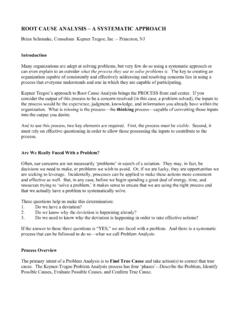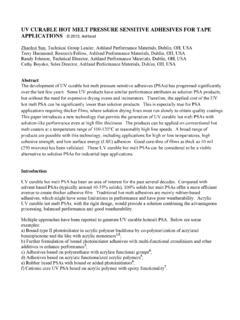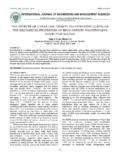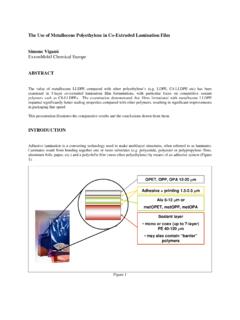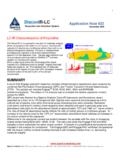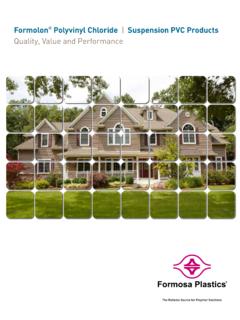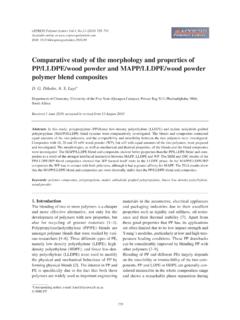Transcription of Modification of Thermoplastic Materials by Electron Beam ...
1 Modification OF Thermoplastic Materials BY Electron beam RADIATION Marcia Navarro, Manager of Fundamental Research & Innovations, Seal for Life Industries, Part of Berry Plastics Engineered Materials Division, San Diego, CA. 1. ABSTRACT Heat shrinkable tapes are used for corrosion protection of pipelines and Electron beam radiation is used to achieve cross-linking. In developing new tapes it is mandatory that the new Materials respond well to the e beam radiation. Cross-linking improves adhesion strength, shear performance, heat distortion and chemical resistance. In the present study copolymer of ethylene and vinyl acetate, ethyl acrylate, butyl a crylate, methyl acrylate, ethyl acrylate, butyl acrylate maleated version, and maleated Linear Low Density Polyethylene were exposed to Electron beam irradiation using a 3 MEV Electron beam Accelerator with varying doses between 4 and 16 Mrads. After the samples were irradiated the following properties were evaluated: tensile stress and elongation at break, hot modulus, gel content, shear modulus and loss tangent, thermal properties and peel adhesion.
2 It was found that all functionalized polyethylenes did cross-link in the e- beam treatment and that the adhesive properties were not affected or did improve. 2. INTRODUCTION Tapes for corrosion protection of pipelines make use of e beam radiation technology to achieve cross-linking. A tape is irradiated and cross-linked at room temperature. Then it is heated above the melting point and stretched out. Finally it is allowed to cool and crystallize in the stretched state, thereby fixing the elongated dimension. Once the tape is heated again, the crystallites melt and the tape can shrink back to the relaxed state. This is very similar to shrink wrap used in packaging. An illustration of such technology is depicted in figure 1 shown in the next page. The tape is wrapped around a pipe, and after heat has been applied, it shrinks and wraps the pipe tightly. The backing of these heat shrinkable tapes is made of polyolefin which are cross-linked as described above.
3 The adhesive in this application is a heat activated hot melt. It softens and wets out easily at the higher temperatures, but is very hard at ambient temperatures and so creates high bond strength to the pipe surface. Figure 1 Heat Shrinkable Product with a Heat Activated Hot Melt Adhesive. On the left the application on the pipe is shown. The black heat shrinkable tape is heated with a blow torch. On the right, a diagram of the tape on the pipe is shown. Ionization radiation has been found to be widely applicable in modifying the structure and properties of polymers, and it can be used to tailor the performance of either bulk Materials or surfaces. More than sixty years of research in polymer radiation chemistry has led to numerous applications of commercial and economic importance. Polymers that cross link maintain their shape and useful properties at elevated temperatures- they do not flow. Generally, they have better creep, strength, resistance to impact, stress cracking, and chemical resistance.
4 On the other hand, cross-linking can decrease wetting properties and tack. Some of the advantages of radiation cross-linking compared to the conventional chemical cross-linking are cost, speed and the ability to cross-link preformed parts at or near room temperature, absence or reduced amounts of chemical ingredients for environmental or toxicological reasons. Several applications, either well established or of exceptional promise for future commercial use are cited by Clough et al 1 publication. Examples are Cross-linking of polymeric foams of automotive cushions, heat insulation, buoyancy products for marine use, and sporting goods. Wire and cable insulation and automotive tires Irradiation in the processing of polymer blends to improve compatibility Electron beam curing of compounds; use in surface coating, printing & packaging Heat shrinkable products (Shrink wrap) Polymer chain scission; PTFE conversion into micro powders to be used as additive in inks and coatings Cross-linked film Heat Activated Hot melt Substrate Closure Surface Modification and grafting; altering surface of Materials , such us films, fibers, powders and molded objects, in order to enhance properties as printability, wet ability, and adhesion with other Materials or with biological components.
5 3. OBJECTIVE In this report some basic concepts associated to cross-linking by ionization radiation are listed which are applicable to those individuals that engage in technologies dealing with ionization radiation. In addition, a study is presented for several functionalized polyethylene samples in terms of their radiation response, when exposed to Electron beam irradiation using a Dynamitron Lineal Accelerator of 3 MeV, in a dose range from 4 to 16 Mrads (40 to 160 kGy). These Materials are used to develop heat activated hot melt adhesive formulations which are used to manufacture heat shrinkable tapes. The purpose of this investigation is to establish if the Materials cross-link in the e beam treatment and if there are any impacts on the adhesive properties. 4. POLYMERS TRANSFORMATION BY Electron beam RADIATION2, 3 Describing the Electron beam process It is a high energy interaction; the energies involved are much greater than the Electron binding energy of any Electron to a nucleus.
6 If differs from (UV) irradiation in which the energy carried per particle (photon) is lower than the ionization energy of an atom or molecule Covalent bonds are broken and formed when polymers are Electron beamed; some polymers can degrade, others can cross-link more predominantly. Can we tell if polymers will cross link or degrade? When the monomer unit of the polymer contains at least one -hydrogen, , cross-linking will take place. Example, see below (-CH2-CR1H- or -CH2-CH2 -), for example polystyrene, polypropylene, polyethylene Polymers with two side chains attached to a single backbone carbon (-CH2-CR1R2-), those containing quaternary C atoms in the main chain will degrade such as polyacrylonitrile, polyvinyl butyral, cellulose, etc. Polymers of CX2-CX2 type (where X is a halogen type), poly(tetrafluoroethylene), degradation is the predominant process, Cross linking of the polymers The mechanism involves the cleavage of a C-H bond on one polymer chain to form a hydrogen atom, followed by the abstraction of second hydrogen from a neighboring chain.
7 The two atoms form the H2 molecule. Then the two adjacent polymeric radicals combine to form a cross-link leading to branching chains until, a three dimensional polymer network is formed. In contrast, scission is the breaking of a C-C bond in the main chain. Cross-linking increases the average molecular weight, whereas scission reduces it. It is difficult to predict the result for a polymer macrostructure after radiation, but one can measure the secondary species generated on irradiation using known analytical techniques such as, swelling, tensile testing, dynamic mechanical and thermal analysis, etc. Units to express the absorbed dose The International System unit of absorbed dose is the Gray (Gy), which is equal to the energy imparted by ionization radiation to a mass of matter corresponding to 1 joule per kilogram. The unit of radiation dose is a special unit, the rad, which is equal to the energy absorption of joule per kilogram that is kGy.
8 For conversion purposes 1 Mrad= to 104 Gy= 10kGy 5. EVALUATIONS OF SAMPLES FOR EXPOSURE TO IONIZATION RADIATION To conduct this study, several functionalized polyethylene Materials were selected based on their possible performance response to ionization irradiation and their selection as potential ingredients to be used to develop heat activated hot melt adhesives. In addition, we chose Materials whose viscosities were relatively high enough to respond to radiation cross-linking. Some authors5, 6, 7 have studied previously Polyethylene (low density and high density), maleated Polyethylene, Polyethylene with Ethyl, Butyl, and Methyl Acrylates, and Vinyl Acetate copolymers. The following table show the samples selected for evaluation and its properties Table 1: Typical Properties for Functionalized Polyolefin Sample ID Functional group % Co monomer Melt Index (MI) g/10 min Melt Temp. C Vicat Temp. C Xc % Density g/cm3 M-15 EVA 18 86 61 M-9 18 88 64 M-10 18 89 68 M-18 25 78 53 M-14 EVA-Acid 25 NA NA M-19 EMA 20 80 48 M-26 29 61 <40 M-25 18 87 55 M-20 23 26 68 36 M-7 EBA 17 - 91 60 M-8 17 92 58 M-27 30 78 45 M-11 17 95 68 M-12 EBA-AA BA: 7 AA: 4 7 96 72 M-24 EEA-MAH EA: MAH: 95 65 NA M-17 NA 97 NA M-23 EBA-MAH BA: 6 MAH: 3 107 80 M-13 BA: 6 MAH: 102 78 M-28 BA: 18 MAH: 3 91 55 NA M-4 EEA 15 M-6 M-1 MAH-LLDPE NA 120 83 M-22 NA 120 87 M-2 NA NA 80 M-3 NA NA 102 M-16 NA 124 74 NA: Not Available, VA= Vinyl Acetate BA= butyl acryl ate, AA= acrylic acid, EA= ethyl acryl ate, MAH= maleic anhydride 6.
9 SAMPLE PREPARATIONS AND TESTING TO ASSESS CROSS LINKING RESPONSE Plaques of 60 5 mil were molded between two Teflon sheets using a hydraulic press at max. 40 K lb/in2 and 150 to 180 C; followed by cooling using a second hydraulic press. Time and pressure were varied depending on the type of Materials . For the hot press the temperatures used varied between 150 and 180 C, based on the type of material ; dwell time was set at 3 min. and the pressure varied between 20K and 30K lb/in2. The second press was set at 10 2 C, with a dwell time of 2 min at 10 K lb/in2. Samples were irradiated in air at room temperature using an Electron beam Linear Accelerator, Model Dynamitron 300/400/1220 with MeV. Three compression molded plaques for each sample were irradiated in a dose range of 4, 8, 12 and 16 Mrads, some specific samples were irradiated at 20 Mrads since they did not respond to lower beam doses. Testing procedures Tensile Properties; dumbbells were made in reference to ISO 527 standard.
10 An Instron 5565 model was used with an Extensometer, model 2603-080. A cross head speed was set at 4 in/min and samples evaluated at 23 2 C to determine tensile stress and elongation at break. Five replicates were tested for each sample. Hot Modulus; is the modulus of the material at elevated temperature and 100 % elongation; strips for the irradiated samples were prepared in reference to ISO 527 standard. An Instron 4465 with an Environmental Chamber capable of controlling temperatures within 2 C of accuracy was used. The cross head speed set was at 2 in/min and samples were elongated by 2 inches and the corresponding hot modulus measured at temperatures between 100 and 150 C, temperature selected depended on the type of material . Five replicates were tested for each sample. Gel content; only irradiated samples were tested for this property, the gel fraction was measured gravimetrically; samples were extracted in boiling decahydronaphthalene for 6 hours.




